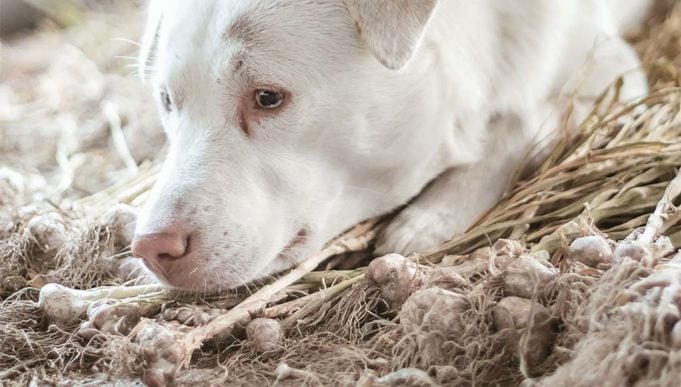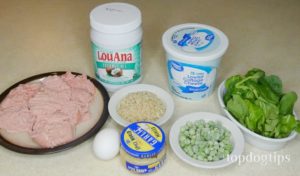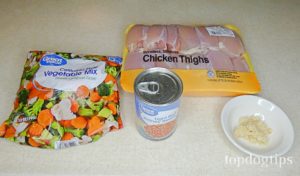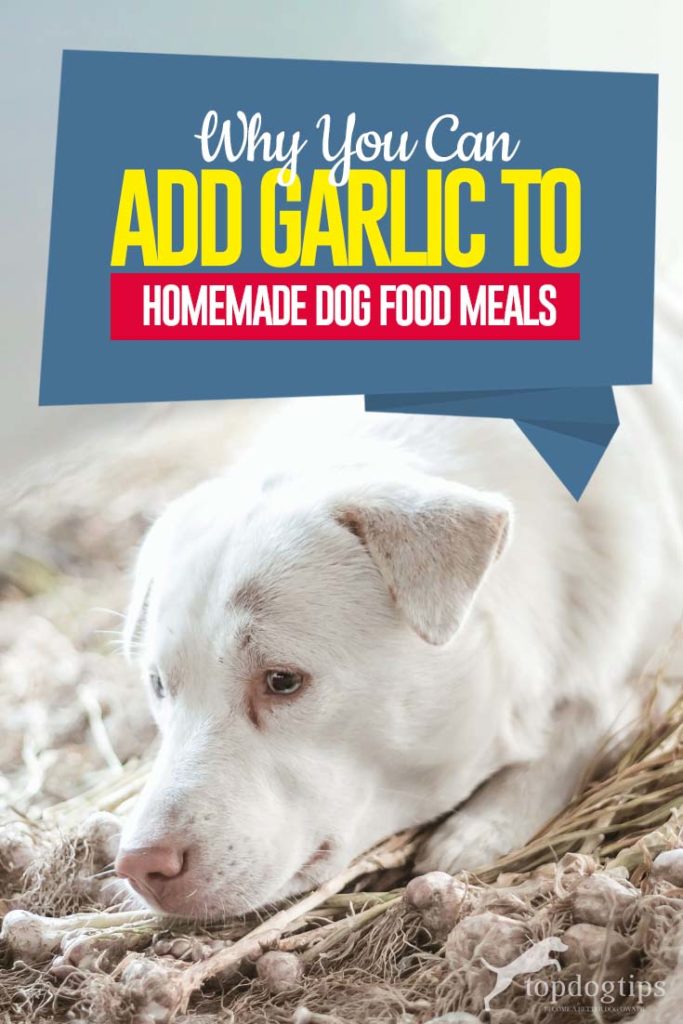If you read and try Samantha's homemade dog food recipes from Top Dog Tips, you may have noticed that some of them contain garlic, like this one and this one. Now, this got you confused: isn't garlic toxic to dogs and should be avoided at all costs? Not really, and I was asked to look at some studies and explain why garlic isn't always dangerous and when it is safe (and even beneficial) to add a little of it to a homemade diet.
Why Is Garlic Controversial?
Garlic is classified as a species of the Allium family, along with onions, shallots, leeks, chives, and rakkyo (Chinese onion). The Allium family contains compounds called disulfides and thiosulphates, but the primary toxin is n-propyl disulfide (Allyl propyl disulfide), and not allicin by itself.
In large doses, n-propyl disulfide can result in conditions known as hemolytic anemia, Heinz-body anemia, and methemoglobinemia. When you give too much garlic to a dog, this can damage red blood cells in the body, resulting in anemia.
Symptoms of this condition can include vomiting and diarrhea, along with regular symptoms of anemia: shortness of breath, lethargy, rapid breathing, elevated heart rate, and pale, yellow, or “muddy” colored gums.
So How Much is Too Much?
There's no argument that, in certain doses, garlic can be dangerous. However, considering how often we hear not to feed garlic to dogs, there's actually very little scientific literature about garlic toxicity in dogs and unsafe dosages. There is some anecdotal evidence of single cases, like where the dog ate both onions and garlic or when a dog was brought in after consuming baked garlic.
In neither of the above-mentioned cases was it noted how much garlic the dog consumed, which could've been extremely large amounts. In the first case in particular, it's likely the onions (which are more toxic than garlic) that caused toxicity, not garlic.
To further test this, a 2000 study done at Hokkaido University took four healthy dogs and gave them each 1.25 ml of garlic extract per kg of body weight for seven straight days (a 50-pound dog would have been fed the equivalent of approx. 25 cloves of garlic).
The result was that even after being given this exorbitant amount of garlic, none of the tested dogs showed any signs of toxicity. Their red blood cells were affected (with no symptoms yet), meaning that if this diet continued, they would likely develop anemia.
Obviously, 25 garlic cloves are not something that any owner is likely to feed their dog.
In a more recent 2018 study, dogs were fed 90 mg/kg/day of aged garlic extract for the whole of 12 weeks. At the end of this period, there were no adverse effects observed in all dogs. Moreover, the scientists saw garlic benefiting the health of these tested dogs.
The conclusion here is that for a dog to be poisoned by garlic, they'd have to consume copious amounts of it for extended periods. Like humans, some dogs may have a lower tolerance to garlic, which could result in a gastrointestinal upset; however, the chances of a dog developing anemia from the consumption of a safe amount of garlic is low to zero.
Using Safe Amounts of Garlic in Homemade Dog Food
When it comes to using garlic in homemade dog food meals, none of Samantha's recipes, or those developed by holistic veterinarians, recommend more than 1-3 cloves of garlic per recipe, which is then further broken down into separate meals. These doses are extremely safe for dogs while also potentially providing health benefits.
If you choose to feed your dog garlic more often, the majority of holistic veterinarians will recommend the following dosage:
Large dogs: 1 clove per day (or half a tsp of garlic powder)
Medium dogs: 1/2 clove per day (or 1/4 tsp of garlic powder)
Small dogs: 1/4 clove per day (or 1-2 pinches of garlic powder)
Another source, Dr. Richard Pitcairn (author of The Complete Guide to Natural Health for Dogs and Cats), has it broken down by pounds and recommends the following amount of fresh garlic according to the size of the dog;
10 to 15 pounds: 1/2 clove of garlic
20 to 40 pounds: 1 clove
45 to 70 pounds: 2 cloves
75 to 90 pounds: 2 1/2 cloves
100 plus pounds: 3 cloves
These doses are likely to be safe for healthy adult dogs and will allow you to reap some of the health benefits garlic can provide to your pet.
Be Mindful of Existing Health Conditions
Just like with any recipe, ingredient, drug, or even commercial kibble, observe your pet for any signs of sensitivities when feeding garlic. It may be better to only use garlic daily as an additional home remedy for minor issues; once the illness has subsided, decrease the amount of garlic and only use it occasionally in your dog's meal.
Furthermore, the above dosage is for mostly healthy adult dogs only and those that do not suffer from certain conditions. When it comes to feeding garlic to dogs, in some cases, this may be more dangerous than in others. For example:
- Anemia – dogs that have been diagnosed with anemia or those predisposed to anemia should not be given any garlic in any amounts whatsoever.
- Pre-surgery – dogs scheduled for surgery should not be fed garlic.
- Lupus – Dogs with this condition have an overactive immune system, which garlic can aggravate, and they should never consume any amount of garlic.
- Puppies – Young dogs do not begin to make new blood cells until after the age of eight weeks and should never be fed any garlic at all.
Consult with a holistic veterinarian before you begin feeding garlic to your dog, as well as before switching to a homemade dog food diet plan. When using fresh garlic, start slowly to avoid stomach upset and never exceed the recommended “dose” for your dog’s weight.
Note: Garlic can be used in all its forms in homemade dog food recipes. However, when fresh garlic is exposed to high heat, it does lose some of its medicinal properties. This is why for recipes that require heating, it's recommended to use garlic powder, which better stands up to being cooked or baked.
Potential Benefits of Garlic for Dogs
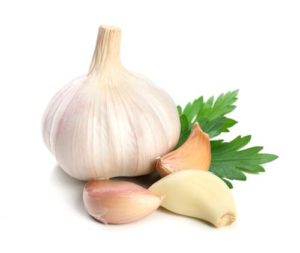 Holistic veterinarians have been recommending garlic for their canine patients for years, but as noted above, there is very little scientific evidence on either the adverse effects or benefits of garlic in dogs.
Holistic veterinarians have been recommending garlic for their canine patients for years, but as noted above, there is very little scientific evidence on either the adverse effects or benefits of garlic in dogs.
In a 2004 study, scientists found that allicin – a compound produced when garlic is chopped or crushed – actually promotes immune functions and prevents cardiovascular diseases in dogs.
A 1981 study, a 1988 study, and a 1992 study also found that garlic is beneficial for dogs with high blood pressure; it improves blood flow and serves as a muscle relaxant.
Finally, there's been a huge amount of studies done on the benefits of garlic in humans, some of which can extend to dogs. Below are some of those benefits based on research.
Boost the Immune System/Fights Cancer. Whether your dog is healthy or needs to boost its immune system, garlic may stimulate the cells in a dog’s system to seek out and destroy invading microbes (including cancer cells).
Fights Viral/Bacterial/Fungal Infections. Garlic has powerful antimicrobial and antibiotic properties. Used fresh, it can fight both internal and external conditions, including parasites such as tapeworms and giardia. It can also fight infections of the mouth, throat, respiratory tract, stomach, or intestines. Crushed garlic diluted in an oil can be used as a topical antiseptic for minor injuries, ear infections, or ear mites.
Lowers Cholesterol and Triglyceride Levels. Fresh garlic can help lower the fats (lipids) in the blood. This can be especially useful for some breeds, such as Beagles and Miniature Schnauzers, that are prone to hyperlipidemia.
Enhances Liver Function. Garlic contains at least six compounds that increase liver function, helping it to release toxins from the body.
Decreases Blood Clots in Veins. A compound found in garlic can reduce the risk of blood clots in the vascular system, which was found in the above-mentioned study.
Flea and Tick Repellent. Although the reasons why are unclear, garlic has been proven to repel both fleas and ticks and is often used in homemade flea remedies.
READ NEXT: 16 Healthy Human Foods for Dogs (That You Haven’t Thought Of)
Disclosure: We may earn affiliate commissions at no cost to you from the links on this page. This did not affect our assessment of products. Read more here and find full disclosure here.
Want to share this?


